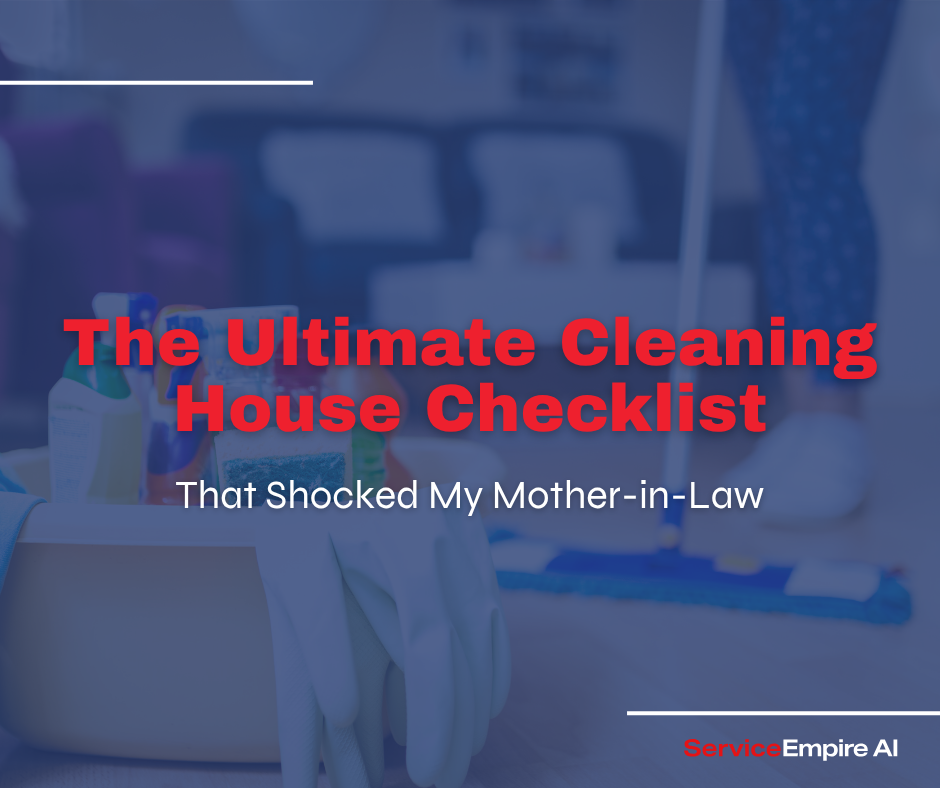
Introduction
A clean home isn’t just nice to look at; it’s also better for your health. Regular cleaning can lower allergies, keep pests away, and reduce breathing problems. Nearly 9 in 10 Americans (87%) feel better mentally and physically when their home is clean.
But for many people, cleaning feels like a big task without a plan. That’s where a cleaning house checklist can help. It turns messy, last-minute cleaning into simple, easy steps. This checklist can also be used for residential cleaning businesses.
Using a cleaning house checklist makes sure you don’t miss anything and keeps you from doing extra work or using too many products. By breaking cleaning into daily, weekly, and monthly tasks, even busy families can keep their homes clean without spending the whole weekend doing it.
This guide gives you helpful cleaning checklists you can print and use for every need—from quick daily jobs to big seasonal cleaning. You’ll also find room-by-room tips to build a cleaning system that fits your home and your schedule.
Benefits of Using a Cleaning House Checklist
Using a structured cleaning house checklist turns home cleaning from a stressful job into a simple, easy-to-follow routine.
Efficiency and Time-Saving
On YouTube, The Minimal Mom shows that one of the ways to reduce total cleaning time by up to 70% is by using a cleaning checklist:
- Eliminates decision fatigue about what to clean next
- Prevents forgetting tasks and having to backtrack
- Creates efficient cleaning pathways through your home
- Reduces time spent searching for cleaning supplies
- Establishes priority systems for limited time windows
Thoroughness and Consistency
Checklists improve cleaning quality too:
- Ensures often-forgotten areas get regular attention
- Reduces the "clean for company" panic cleaning
- Maintains consistent standards throughout the home
- Prevents buildup of dirt that requires more intensive cleaning
- Creates accountability for completed tasks
Reduced Cleaning Product Waste
Systematic cleaning leads to more economical product use:
- Prevents overuse of cleaning solutions
- Encourages appropriate product selection for each task
- Reduces impulse purchases of unnecessary cleaning products
- Creates awareness of supply inventory
- Supports better storage and organization of cleaning supplies
Task Distribution and Household Harmony
Checklists facilitate better cooperation among household members:
- Clearly defines responsibilities for each person
- Reduces arguments about who should do what
- Provides visual confirmation of completed tasks
- Creates fair distribution of cleaning burdens
- Helps teach children responsible home maintenance
Numerous sources show when kids have chores and responsibilities at home, it increases their confidence, emotional health, and decision-making ability long-term.
Types of Cleaning Checklists
Different cleaning checklists serve various purposes. Check out the table below to understand the scope and purpose of each type. Then, you'll be able to use the right system for your needs.
Downloadable / Printable Cleaning Checklists
Daily Cleaning House Checklist [LINK]
Weekly Cleaning House Checklist [LINK]
Monthly Cleaning Tasks Checklist [LINK]
Seasonal Cleaning House Checklist [LINK]
Room-by-Room Cleaning Checklists [LINK]
Deep Cleaning House Checklist [LINK]
Move-In/Move-Out Cleaning Checklist [LINK]
Cleaning Supply Checklist [LINK]
Cleaning House Checklist for Professional Services [LINK]
The checklists above work whether you're a homeowner doing the cleaning yourself, or if you're a professional cleaning service looking for a standard operating procedure / checklist. If you're looking to start a professional cleaning business or rename your existing one, check out the article on cleaning business names.
15-Minute Speed Cleaning Routine (When Time is Limited)
- Start at your front door and work clockwise through main living areas
- Focus only on visible surfaces and high-traffic areas
- Carry a basket to collect items that belong elsewhere
- Use this hierarchy: 1) Trash 2) Clutter 3) Surfaces
- Save actual cleaning for after decluttering is complete
Day-by-Day Breakdown Option
If you're a homeowner looking for a day-by-day cleaning schedule, this could meet your needs. Or, if you're a daily maid service for a homeowner, you could break up your weekly tasks like this:
Monday:
- Bathroom deep clean
- Laundry day
Tuesday:
- Kitchen deep clean
- Trash and recycling
Wednesday:
- Dusting day
- Wipe down electronics
Thursday:
- Vacuum and floor care
- Quick bathroom refresh
Friday:
- Change linens
- Kitchen refresh
Saturday:
- Catch-up day for missed tasks
- Special projects
Sunday:
- Prepare for the week ahead
- Rest and minimal cleaning
Cleaning Supply Checklist
Having the right tools for each cleaning task improves efficiency and results. This comprehensive supply list ensures you have everything needed for routine and deep cleaning.
Essential Cleaning Products
- All-purpose cleaner
- Glass and mirror cleaner
- Bathroom cleaner/disinfectant
- Toilet bowl cleaner
- Floor cleaner appropriate for your floor types
- Kitchen degreaser
- Oven cleaner
- Furniture polish/wood cleaner
- Stainless steel cleaner (if applicable)
- Carpet spot cleaner
- Disinfectant spray or wipes
- Laundry detergent
- Fabric refresher
- Dishwashing liquid
- Dishwasher detergent (if applicable)
Must-Have Cleaning Tools
- Microfiber cloths (multiple colors for different areas)
- Scrub brushes (various sizes)
- Toilet brush and holder
- Squeegee for shower and windows
- Broom and dustpan
- Mop (microfiber or traditional)
- Vacuum cleaner with attachments
- Duster with extension handle
- Spray bottles for homemade solutions
- Bucket
- Rubber gloves
- Scrub sponges and non-scratch scouring pads
- Trash bags
- Caddy or tote for carrying supplies
- Step stool for reaching high areas
Eco-Friendly Cleaning Alternatives
- White vinegar (all-purpose cleaner, fabric softener)
- Baking soda (scrubbing, deodorizing)
- Hydrogen peroxide (stain removal, disinfecting)
- Castile soap (all-purpose cleaning)
- Essential oils (scenting, some antimicrobial properties)
- Lemon juice (degreasing, brightening)
- Microfiber cloths (reducing paper towel usage)
- Reusable spray bottles and containers
- Biodegradable cleaning wipes
- Plant-based cleaning products
Multi-Purpose Product Suggestions
These versatile products reduce the need for numerous specialized cleaners:
- White Vinegar: Use for windows, descaling, fabric softening, and general cleaning
- Castile Soap: Works for hand soap, all-purpose cleaner, and laundry
- Baking Soda: Effective for scrubbing, deodorizing, and drain cleaning
- Microfiber Cloths: Replace paper towels, dusting tools, and special cloths
- Hydrogen Peroxide: Disinfectant, stain remover, and mold treatment
Creating a Custom Cleaning Schedule
A personalized cleaning schedule accommodates your household's unique needs, preferences, and constraints.
Household Needs Assessment
Start by evaluating your specific situation:
- House size and layout: Larger homes require more time or task distribution
- Household composition: Number of people, ages, pets
- Activity level: Work schedules, hobbies, entertaining frequency
- Special considerations: Allergies, health conditions, mobility limitations
- Problem areas: Spaces that get dirtier quickly or need extra attention
- Seasonal factors: Changes in cleaning needs throughout the year
Available Time Realistic Planning
Be honest about time constraints:
- Track available time blocks: When can cleaning realistically fit into your schedule?
- Determine energy levels: When are you most productive for cleaning tasks?
- Identify scheduling conflicts: Work, children's activities, social commitments
- Account for interruptions: Plan cleaning when distractions are minimized
- Build in flexibility: Allow for unexpected events and schedule changes
- Balance cleaning with rest: Avoid burnout by including downtime
Family Member Capability Matching
Assign tasks based on abilities and preferences:
- Age-appropriate tasks: Match chores to developmental capabilities
- Physical limitations: Consider mobility, strength, and stamina
- Skill levels: Assign tasks based on proficiency and training
- Preferences: When possible, assign tasks people dislike less
- Time availability: Match tasks to each person's schedule
- Create a skills development plan: Gradually introduce new cleaning skills
Priority Task Identification
Not all cleaning tasks are equally important:
- Health-impact tasks: Prioritize cleaning that affects wellbeing (bathroom sanitizing, kitchen hygiene)
- Visible area focus: Maintain public spaces more frequently
- Guest impression areas: Prioritize spaces visitors see regularly
- Personal comfort zones: Focus on areas that impact your daily comfort
- Maintenance-critical tasks: Address issues that prevent long-term damage
- Seasonal priorities: Adjust based on weather, activities, and holidays
Conclusion
A well-structured cleaning house checklist takes what often feels like an overwhelming task and makes it into manageable, systematic routines that maintain a healthier, more organized living environment. By breaking cleaning into daily, weekly, monthly, and seasonal components, you create a sustainable approach that prevents the need for exhausting marathon cleaning sessions while keeping your home consistently presentable.
The printable checklists provided in this guide serve as templates you can customize to your specific household needs, preferences, and constraints. Whether you're managing a busy family home, preparing for special occasions, or setting up cleaning routines in a new residence, these structured approaches help ensure no area gets overlooked.
Remember that the perfect cleaning routine is one that works for your unique situation. Feel free to adapt these cleaning house checklists to create a personalized system that balances cleanliness goals with available time and energy. The most effective cleaning schedule is one you can maintain consistently, bringing order and cleanliness to your home without creating undue stress or pressure.
Who knows, you may keep a house so clean, it impresses your mother-in-law too!
FAQ Section
How often should I deep clean my house?
Most homes benefit from deep cleaning 2-4 times per year, though this varies based on household factors. Consider scheduling deep cleaning seasonally (4 times yearly) to address changing needs throughout the year. Households with children, pets, allergies, or respiratory conditions may need more frequent deep cleaning (every 2-3 months). High-traffic homes or those that entertain frequently should deep clean quarterly, while single-person households with minimal mess might only need 1-2 annual deep cleans. For optimal results, supplement these deep cleaning sessions with consistent daily and weekly maintenance to prevent significant buildup.
What's the most efficient order to clean a house?
The most efficient cleaning approach follows a "top-to-bottom, dry-to-wet" strategy, starting with dusting high surfaces so that debris falls to floors that haven't yet been cleaned. Begin with decluttering all rooms, then dust and clean ceilings, light fixtures, and high surfaces. Work downward to furniture, countertops, and other mid-level surfaces before finishing with floors. Clean dry surfaces (dusting) before wet cleaning (mopping). For whole-house cleaning, start with the furthest room from the entrance (typically bedrooms) and work toward the entryway to avoid retracing steps through clean areas. Always clean kitchens and bathrooms last since they require the most attention and different cleaning products.
How do I create a cleaning schedule for a large family?
Effective large-family cleaning schedules distribute responsibilities across all capable household members. Start by listing all cleaning tasks and categorizing them by frequency (daily, weekly, monthly). Assign age-appropriate chores to each family member based on their abilities and schedules—younger children can handle simple tasks like picking up toys, while teens can take responsibility for entire rooms. Create a visual chart showing each person's responsibilities and use color coding for easy reference. Consider implementing a "zone defense" approach where each person is responsible for specific areas rather than specific tasks. Include "all hands" cleaning sessions once weekly where everyone works together for 30-60 minutes. Finally, establish both individual accountability and team rewards to motivate consistent participation.
What are the must-do daily cleaning tasks?
The essential daily cleaning tasks that prevent buildup and maintain basic cleanliness include: making beds, which immediately improves room appearance; washing dishes or loading/unloading the dishwasher to prevent food residue and pest issues; wiping kitchen counters and the stove to eliminate food contamination; a quick bathroom sink and counter wipe-down to control bacteria; sweeping high-traffic floor areas, especially entryways and the kitchen; and a 10-minute decluttering session to return items to their proper places. These six tasks require just 15-20 minutes total but make a dramatic difference in maintaining home cleanliness and preventing the need for more intensive cleaning later. Focus on these fundamentals even on your busiest days.
How do I maintain a cleaning routine when I work full-time?
Maintaining a clean home with a full-time work schedule requires strategic time management and simplified systems. First, implement the "one-touch rule"—put items away immediately rather than setting them down temporarily. Designate 15-20 minutes each weekday for high-impact cleaning (kitchen counters, quick bathroom wipe-down, and 10-minute pickup). Invest in quality tools that make cleaning faster, such as a stick vacuum for quick cleanups.
Distribute weekly cleaning tasks throughout the week rather than trying to clean everything on weekends—for example, bathrooms on Monday, vacuuming on Wednesday, dusting on Thursday. Consider whether your budget allows for occasional professional cleaning services for deep cleaning tasks. Finally, involve all household members by assigning age-appropriate responsibilities to ensure cleaning doesn't fall solely on one person.
How long should a thorough house cleaning take?
A thorough cleaning of an average 3-bedroom, 2-bathroom home (approximately 1,500-2,000 square feet) typically takes 2.5-3.5 hours for regular weekly cleaning and 5-8 hours for deep cleaning. Factors affecting this timeframe include current cleanliness level, home size, number of bathrooms, amount of clutter, flooring types, and cleaning efficiency. Professional cleaning teams with 2-3 people can complete regular cleaning in 1.5-2 hours because they work simultaneously in different areas with specialized equipment. Cleaning duration also depends significantly on experience and systematic approach—those who clean regularly and follow an organized routine will work much faster than those who clean sporadically. For optimal efficiency, declutter before cleaning and use the room-by-room approach provided in this guide.
What cleaning tasks can be delegated to children?
Children can participate in age-appropriate cleaning tasks that teach responsibility while lightening the overall household workload. Preschoolers (ages 3-5) can handle simple tasks like putting away toys, placing dirty clothes in hampers, helping make their beds, and wiping up spills with supervision. Elementary-aged children (6-9) can feed pets, empty small trash cans, dust accessible surfaces, help unload the dishwasher, and vacuum open areas. Preteens (10-12) can load the dishwasher, change bed linens, clean bathrooms with guidance, vacuum thoroughly, and take out trash. Teenagers should be capable of any cleaning task including laundry, complete bathroom cleaning, kitchen cleanup, and window washing. Create clear visual checklists for younger children and consider rotating responsibilities to build broader skills. Always recognize and appreciate their contributions, focusing on effort rather than perfection.






